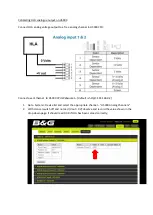
11
Tracks User Manual
Cleaning the Tracks
To clean the rubber tracks, use non-petrol based cleaning agents such as soap and water. Questions regarding the rubber
track’s compatibility with specific chemical agents should be directed to Goodyear.
Rotate Tracks
If uneven lateral wear is noticed, rotate the tracks from side to side. This is particularly true in situations where the track exhibits
accelerated wear on either the extreme inboard or extreme outboard edges .
Periodic Storage
When a rubber tracked machine is to be stored, the following recommendations should be considered. If storing for longer than
three (3) months, the guidelines presented in Long Term Track Storage (see Page 11) should also be considered.
Avoid Storing in Sunlight
Long-term exposure to the ultraviolet rays in sunlight can degrade rubber, causing it to become brittle and causing it to exhibit
arrays of fine cracks (commonly perceived as the rubber “drying out” and sometimes called “weather checked”). It is best to
store the tracked machine indoors whenever possible. If the tracked machine must be stored outdoors, the tracks should be
covered. An opaque tarpaulin is usually satisfactory for this purpose.
Long Term Storage
When a tracked machine is to be stored for a prolonged period, three (3) months or more, the following guidelines should be
observed.
Avoid Direct Sunlight
As mentioned in Periodic Storage, long-term exposure to the ultraviolet rays in sunlight can degrade rubber causing it to become
brittle and causing it to exhibit arrays of fine cracks. It is best to store the tracked machine indoors whenever possible. If the
tracked machine must be stored outdoors, the tracks should be covered. An opaque tarpaulin is usually satisfactory for this
purpose .
Avoid High Temperatures
While rubber tracks can endure a significant range of temperatures (-50
°
F to 125
°
F [-45
°
C to 52
°
C]), prolonged storage at
elevated temperatures can be damaging. Lower temperatures are not as objectionable for storage. In general, the tracked
machine should not be stored at temperatures above 85
°
F (29
°
C) for extended periods of time. Ideally the machine should be
stored in a cool environment with the temperature kept between 40
°
F and 60
°
F (4
°
C and 16
°
C).
Avoid Air in Motion
All rubber is susceptible to ozone (O
3
) which is a standard element of common air. Like ultraviolet light, ozone causes rubber to
become brittle and exhibit arrays of fine cracks. If the tracked machine is stored in a drafty location, a greater amount of ozone
will come into contact with the exposed rubber surfaces than would still air resulting in accelerated degradation . If the tracked
machine must be stored outdoors, use an opaque tarpaulin to protect the tracks from the wind.
Avoid Electric Devices
Most electric devices, especially electric motors, generate ozone. Specifically, ozone is generated by the arcing of electricity
through the air; therefore, any electrical device which uses spark-gaps or brushes generates high levels of ozone. As ozone
degrades rubber, the tracked machine should not be stored in closed areas with motors or other electric devices.
Do No Paint Tracks
It was once a common belief that painting rubber tires and tracks would protect them from ozone and ultraviolet light. In fact, the
painting of rubber can be detrimental for two reasons:
•
The chemical agents contained in many paints are themselves caustic to rubber
•
The skin formed by the paint prevents the various emollients and waxes in the rubber from migrating to the surface and
sublimating. These agents become trapped between the surface of the track and the paint and, with high concentration
at those locations, causes the physical properties of the rubber to be altered.
MAINTENANCE
Track Maintenance (Continued)
Summary of Contents for FIELD FLOATER 6
Page 2: ...Serial Number Date of Purchase Purchased From Dealer s Address Dealer s Telephone ...
Page 4: ......
Page 8: ...4 Field Floater 6 Grain Cart User Manual ...
Page 9: ...Field Floater 6 Grain Cart User Manual 5 Safety ...
Page 15: ...Field Floater 6 Grain Cart User Manual 11 Technical Data ...
Page 18: ...14 Field Floater 6 Grain Cart User Manual ...
Page 19: ...Field Floater 6 Grain Cart User Manual 15 Operation ...
Page 39: ...Field Floater 6 Grain Cart User Manual 35 Maintenance ...
Page 52: ...48 Field Floater 6 Grain Cart User Manual ...
Page 53: ...Field Floater 6 Grain Cart User Manual 49 Troubleshooting ...
Page 60: ...56 Field Floater 6 Grain Cart User Manual ...
Page 61: ...Field Floater 6 Grain Cart User Manual 57 Weigh System Programming ...
Page 78: ...74 Field Floater 6 Grain Cart User Manual ...
Page 79: ...Field Floater 6 Grain Cart User Manual 75 Notes ...
Page 80: ...76 Field Floater 6 Grain Cart User Manual Date Notes NOTES ...
Page 81: ...77 Field Floater 6 Grain Cart User Manual Date Notes NOTES ...
Page 82: ...78 Field Floater 6 Grain Cart User Manual Date Notes NOTES ...
Page 83: ......
Page 86: ...Serial Number Date of Purchase Purchased From Dealer s Address Dealer s Telephone ...
Page 88: ......
Page 91: ...Tracks User Manual 3 Technical Data ...
Page 93: ...Tracks User Manual 5 Operation ...
Page 97: ...Tracks User Manual 9 Maintenance ...
Page 103: ...Tracks User Manual 15 Notes ...
Page 104: ...16 Tracks User Manual Date Notes NOTES ...
Page 105: ...17 Tracks User Manual Date Notes NOTES ...
Page 106: ...18 Tracks User Manual Date Notes NOTES ...
Page 107: ......










































